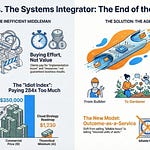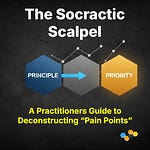Introduction: The Illusion of Prevention in the Age of AI
Let's talk about the game you're playing. Right now, as generative AI weaves itself into the fabric of every industry, you're likely playing a frantic game of checkers. Your valuable intellectual property—your source code, your product designs, your marketing strategies—are the pieces. And you're desperately moving them around the board, trying to king them, trying to protect them from an opponent who can be anywhere, move in any direction, and capture you without ever seeming to try.
That opponent is the risk of AI-driven IP theft. And it's a game you're going to lose.
The fear is real and justified. We pour our souls into creating something new, only to worry that a sophisticated model, or an employee using a public AI tool, could leak our secret sauce to the world in an instant. The default response? Defense. We build higher walls, encrypt our data, and double down on NDAs. We play checkers.
But this is a strategic trap. A purely defensive posture against a technology as pervasive and fast-moving as AI doesn't just consume your resources—it actively stifles the very creativity it's supposed to protect. It makes you slow, cautious, and paranoid.
This article proposes a new game. It's time to stop playing checkers and start playing chess.
The winning move isn't about protecting a static asset. It's about building a dynamic, un-copyable innovation capability. It's about creating a competitive moat so deep and wide that by the time a competitor steals the blueprint for your castle, you're already living in a skyscraper on the other side. This is the playbook for making IP theft irrelevant.
Part 1: Deconstructing "IP Theft" with First Principles
To escape the defensive trap, we have to stop thinking by analogy ("How have we always protected secrets?") and start thinking from first principles. The physicist and innovator Elon Musk outlines a simple, powerful three-step process we can use to deconstruct this problem.
Step 1: Identify Your Current Assumptions
First, let's voice the assumptions that are trapping us in a game of checkers:
We assume our IP is a thing—a file, a document, a block of code.
We assume this thing has intrinsic value.
We assume the goal is to prevent this thing from being copied or seen by others.
We assume that with enough security, we can achieve this goal.
These assumptions lead us to build digital fortresses. But are they true?
Step 2: Break the Problem into its Fundamental Truths
Now, let's break "IP theft by AI" down to its absolute basics.
What is Intellectual Property, fundamentally? It’s not a file; it's valuable information representing a novel solution to a problem.
What is Generative AI, fundamentally? It's a pattern-processing machine. It ingests vast amounts of information and learns the patterns within it to generate new, statistically probable outputs. It doesn't "think"; it remixes and reconstructs based on the patterns it has absorbed.
What is the value, fundamentally? The value of your IP isn't just in the final pattern (the design file or source code). That's just the final artifact. The true, defensible value lies in the entire system that created it:
The unique customer insights and unmet needs you discovered (your Jobs-to-be-Done research).
The proprietary process you used to translate those needs into a solution.
The exclusive data that informed the process.
The integrated system that the IP plugs into to deliver value to a customer.
Step 3: Rebuild a New Strategy from Scratch
Reasoning up from these fundamental truths, a new strategy becomes clear. If the final artifact is the most vulnerable and least valuable part of the equation, then a robust strategy cannot be centered on protecting it.
A new strategy, built from first principles, must focus on making the entire value-generating system defensible. You don't guard the golden egg; you build an un-copyable golden goose. This means your focus must shift from protecting your Product Performance innovation to building a moat with other, harder-to-copy forms of innovation.
Part 2: The Moat Strategy: Making Your Innovation Un-Stealable
Your new game is about building a moat. A moat doesn't just make your castle harder to breach; it makes the entire landscape hostile to an attacker. In business, this moat is your sustainable competitive advantage.
The consulting firm Doblin identified that the most resilient companies don't just innovate on their products; they innovate across 10 distinct types of innovation. While innovating your product is important, it's often the easiest for competitors to copy. A true moat comes from strategically combining multiple types of innovation.
Let's focus on three types of innovation that are exceptionally difficult to steal and form the cornerstones of your moat.
Deep Dive 1: Process Innovation – Your Uncopyable Workflow
This is your "how." It's the unique, proprietary way your organization turns insights into value. A competitor might steal your code, but they can't steal your culture of innovation, your proprietary workflows, or the unique way you leverage AI itself.
How to Build a Process Moat:
Use Jobs-to-be-Done (JTBD) to Design a Superior Process: Your innovation process shouldn't be generic. It should be explicitly designed to solve a "job" for your own team: "Help us consistently uncover and solve high-value, unmet customer needs." By applying JTBD to yourself, you can design a workflow that is uniquely effective for your market.
Leverage a Superior Prioritization Model: Most companies use flawed methods to prioritize what they build. They rely on biased scoring systems that can amplify statistical errors and misrepresent the true landscape of customer needs. By adopting a more statistically robust and transparent method—like the Percentages and Ranks approach, which focuses on the actual percentage of underserved customers—you create a defensible process advantage. Your process will consistently target higher-value opportunities that your competitors, using inferior models, will literally never see. This isn't just a slight edge; it's an unfair advantage baked directly into your workflow.
Make AI a Part of the Process: Don't just use AI to write code; use it to supercharge your process. Train a private AI model on your successful JTBD interview transcripts to identify "desired outcome statements." 😏 Build a custom GPT that acts as a "devil's advocate" to challenge your team's assumptions based on your unique repository of market data. This makes the AI an integral part of your uncopyable workflow, not just a tool that can be used against you.
Deep Dive 2: Network & Channel Innovation – A Proprietary Ecosystem
This is your "who" and your "where." The value of your IP is amplified by the ecosystem it exists within. An idea in a vacuum is worthless; an idea connected to a powerful network is a game-changer.
How to Build a Network Moat:
Exclusive Data Partnerships: Forge alliances to gain access to data streams your competitors don't have. This could be anything from proprietary market data to real-time usage data from a partner's platform. This unique data becomes the fuel for your superior innovation process.
Customer Co-Creation Communities: Move beyond simple feedback surveys. Create an engaged community of your best customers who actively participate in the innovation process. They provide insights, test prototypes, and become evangelists. A thief can't steal this community trust or the nuanced insights it generates.
Innovative Channels: How you deliver your IP can be as innovative as the IP itself. Is it delivered through an API that's deeply integrated into a major platform? Is it accessed through a personalized onboarding service that ensures customer success? A superior channel creates stickiness and a better customer experience that can't be replicated by simply copying a file. 7
Deep Dive 3: Structure & Profit Model Innovation – Your Unfair Advantage
This is your "why" and your "how much." How you organize your talent and how you make money are deeply intertwined and can form a powerful, self-reinforcing moat.
How to Build a Structural and Financial Moat:
Organize Around the Job-to-be-Done: Instead of traditional departments like "marketing" and "engineering," structure small, autonomous, cross-functional teams around a specific customer Job-to-be-Done (e.g., the "Help me create a building" team from our earlier example). This creates deep, defensible expertise and an execution speed that siloed organizations can't match.
Align Your Profit Model with Your Moat: Your pricing shouldn't be an afterthought. It should reinforce your competitive advantage.
Process-Based Pricing: If your moat is a superior, AI-driven process, your profit model could be usage-based. The more a customer uses it, the more data it gets, the smarter it becomes, and the more value it delivers—a virtuous cycle.
Network-Based Pricing: If your moat is your network, your model could include profit-sharing with partners, creating a powerful incentive for them to strengthen your ecosystem and lock out competitors.
By weaving these elements together—a superior Process, a proprietary Network, and an aligned Structure & Profit Model—you create a system where the Product is just the tip of the iceberg. A competitor who only steals the product is left with a useless component of a machine they can't possibly hope to rebuild.
Part 3: The Future of IP - Novel Concepts for a New Era
To truly future-proof your strategy, you have to elevate the level of abstraction. It's not just about protecting today's ideas; it's about building the capability to generate tomorrow's, in a way that is inherently more defensible. Here are concepts—some working today, some on the horizon—that get the job of "protecting IP" done completely differently, better, and at a lower cost.
Working Today (But Few Are Doing It): Dynamic IP Generation
The old model assumes IP is a single, static asset created for a mass market. The new model treats IP as a dynamic, generative capability.
The Concept: The core IP is no longer the final CAD file or the compiled code. The real IP is the master prompt-chain, workflow, and proprietary dataset that allows you to generate a bespoke solution for each customer's unique context. Imagine a service that designs custom circuit boards. A competitor might steal the single design file sent to one customer. But they haven't stolen the engine—the AI-powered system that can generate a million different, optimized designs based on a user's specific inputs (size, power requirements, heat tolerance, etc.).
Why it's Defensible: You're selling a constantly evolving capability, not a static product. The value is in the generative process. The output is just a temporary artifact of that value. This gets the job of "acquiring a solution" done for the customer in a vastly superior way, with far fewer visible features for them to worry about.
Novel Future Concept 1: Embedded IP Contracts
This concept shifts protection from the legal world to the code itself.
The Concept: Imagine a future where every piece of digital IP—a 3D model, a piece of software, a strategic document—has a smart contract embedded directly within its file structure. This contract cryptographically enforces the terms of use. The 3D model can only be opened by a licensed printer. The software module will only execute if it's part of the authorized system. The strategic plan blurs itself out if opened on an unauthorized device.
Why it's a Game-Changer: It gets the job of "enforcing IP rights" done completely differently and at a lower cost. It moves enforcement from a slow, expensive legal process to an automated, instantaneous, code-based reality.
Novel Future Concept 2: Process-as-a-Service (PaaS) Innovation
This is the ultimate evolution of the process moat—a complete business model transformation.
The Concept: Instead of selling the output of your innovation (the IP artifact), you sell access to your unique, AI-driven innovation process. Customers come to your platform with their problem (their Job-to-be-Done). They use your proprietary tools, guided workflows, and AI assistants to develop their own solution. Your core IP—the process itself—never leaves your secure system. The customer leaves with their solution, and you retain the learnings from their session to make your process even smarter for the next customer.
Why it's Defensible: This is the ultimate moat. You aren't just protecting your IP; you're creating a platform where the world comes to create its own IP. Your value is in the factory, not the widgets.
Part 4: Your Playbook for Building an Innovation Moat
This might feel theoretical, but you can start building your moat today. Here’s a simple playbook to get you started.
Audit Your Defenses: Take out a piece of paper and draw the 10 Types of Innovation. Now, map your current IP and your strategy for protecting it. Is everything piled into the "Product Performance" box? Be honest. This map will show you your vulnerabilities.
Define the Core Job: Forget your product for a minute. Talk to your customers. Use the Five Whys technique to understand the real, high-level job they are hiring your solution to do. Why do they need that report? Why is that information important? Why does that outcome matter? Getting this right is the foundation of your entire strategy.
Pick Your Moat: Looking at your audit, choose one or two non-product innovation types to focus on this quarter. Is it Process? Could you map out and streamline your innovation workflow? Is it Network? Could you identify one key data partner that would give you an unfair advantage?
Launch a Pilot: You don't need to rebuild your company overnight. Design a small-scale, low-risk experiment. For example, create a "Customer Advisory Board" (a Network innovation pilot) and give them early access to your tools to co-create one new feature. Measure the quality of the insights. This pilot will give you the data and the momentum needed to justify a larger strategic shift.
Conclusion: Play Chess, Not Checkers
The arrival of generative AI doesn't have to be a threat to your intellectual property. It's an invitation to play a better game.
For too long, we've been playing checkers—reactively defending static assets in a world that is becoming more dynamic by the second. This is a game of attrition, and it's a game we will lose.
The only winning move is to change the game entirely. By thinking from first principles, you can see that true value lies not in the artifact, but in the system that creates it. By using frameworks like Doblin's 10 Types of Innovation and Jobs-to-be-Done, you can stop building walls and start digging moats.
Focus on building an un-copyable Process. Weave an inimitable Network. Engineer a reinforcing Profit Model. When you do this, you're no longer just protecting pieces on a board. You're controlling the entire game. The goal is not to have un-stealable IP; it is to be an un-copyable innovator.
Reference Table: A Systematic Approach to Creativity
The novel concepts discussed in Part 3 weren't pulled from thin air. They were derived by systematically applying creativity triggers. This table shows their origin.
Which of the 10 Types of Innovation represents the biggest opportunity for you to build a moat around your core IP? Share your thoughts in the comments below.
Follow me on 𝕏: https://x.com/mikeboysen
If you'd like to see how I apply a higher level of abstraction to the front-end of innovation, please reach out. My availability is limited.
Mike Boysen - www.pjtbd.com
Why fail fast when you can succeed the first time?
Masterclass: https://pjtbd.com/mc
My Blog: https://jtbd.one
📆 Book an appointment: https://pjtbd.com/book-mike
Join our community: https://pjtbd.com/join














